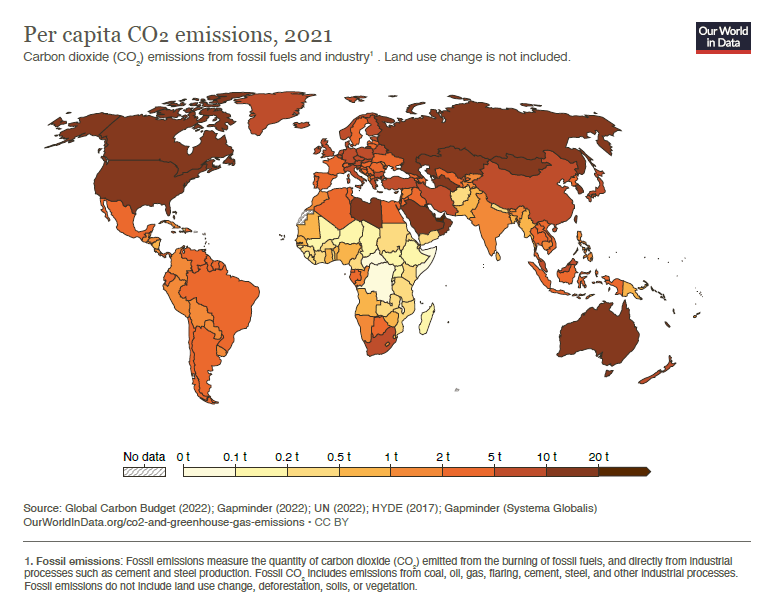And time and again it hits Africa. The continent suffers the most from the consequences of climate change – and this despite the fact that the states and people are not responsible for the rise in temperatures. At less than four percent, the continent contributes very little to climate-damaging greenhouse gas emissions. In comparison: Europe caused an average of slightly more than ten percent in the last two years – with only half as many inhabitants. This is shown by data from “Our World in Data”.
“The poorest people in the developing countries are the most helpless and at the same time the most affected by the climate crisis,” says Sonja Tschirren, climate expert at SWISSAID. On the African continent, this is a matter of survival: since 1961, agricultural yields there have fallen by more than a third. More than in any other region of the world. Because the soil is silting up. Because the water is drying up. Several million people have had to leave their homes because of this.

“The Sahel is a focal point of climate change. Heavy rainfall alternates with dry periods here.”
Kiswendsida Guigma
One region that is particularly affected is the Sahel. “This is a focal point of climate change. Heavy rainfall alternates with dry periods here. Extreme weather events are becoming more intense, more widespread and more frequent,” says Kiswendsida Guigma. The climate scientist is responsible for West Africa and the Sahel for the Climate Centre, which belongs to the Red Cross.
Like everywhere in Africa, the heat is widespread. In most regions, 40 degrees is the norm. “But temperatures rise up to 45 degrees. Health suffers as a result. Water supplies and crops decrease, and hunger increases.”
This is what Diamnda Merci Memhodjim sees in her daily work in remote regions of Chad. “In the countryside, the situation is particularly critical. There is often only one meal a day and not three as in Switzerland. More and more often, even days without food have to be survived. The women go without first and leave the food to the men and children. People who live from cattle farming travel long distances to get to areas where there is still food,” says the SWISSAID project manager.
More and more emergency aid
This spring, the West African country also experienced heavy rainfall. According to the national meteorological authority, the rainfall in Chad was the heaviest since 1990. Whole swathes of land were under water. Thanks to its long-standing roots in the country, SWISSAID was able to distribute food parcels to around 12,000 people within a very short space of time – thus alleviating the worst of the hunger.

They defy adverse living conditions in Niger: Djamila Abdoulaye with her daughter.
The neighbouring state of Niger is no better off. Currently, 2.8 million lives are again at risk. SWISSAID launched an emergency aid project in the country a year ago. At that time, severe droughts destroyed the harvest. “We suffered from hunger – even the children had nothing to eat and were constantly ill,” Djamila Abdoulaye recalls. The 30-year-old mother received food parcels and fast-growing seeds so that the smallholder farmer could cultivate her fields and later harvest them. “With this, I can feed my family today!” she says happily.
Although the situation in her village is not stable – at least no one has to go hungry. But to help people like Djamila Abdoulaye in the long term, a change in thinking is needed. “It is necessary to introduce climate-compatible agriculture with adaptation strategies at local level,” says Kiswendsida Guigma.
SWISSAID climate expert Sonja Tschirren agrees. “In our project areas, we have been working for years with women smallholders to find ways to defy climate change.
There are hopeful approaches. Especially when it comes to seeds. For example, there are various types of millet that grow with little water and can withstand light droughts. Native legume species such as the Bambara groundnut and helmet beans enrich the soil with additional nitrogen – and help to prevent malnutrition. These plants are rich in proteins, minerals and vitamins.

They defy adverse living conditions in Niger: Djamila Abdoulaye with her daughter.
Diversity as a plus
Diversity is an invaluable treasure. In times of climate change, diversity is needed in the fields: Plants with short growth cycles, with longer ones, those that sprout better in heat, and those that survive with plenty of water. In order to help the people in the affected areas efficiently, SWISSAID is now relying in its projects on village committees that are trained in climate issues. These receive and disseminate data from a weather station in order to flexibly plan the harvest cycle accordingly.
Because one thing is clear: the climate crisis can only be overcome if everyone works together. Guigma Kiswendsida: “The North and the South are part of the same planet. Only together can solutions and ways be found to overcome the crisis.”
